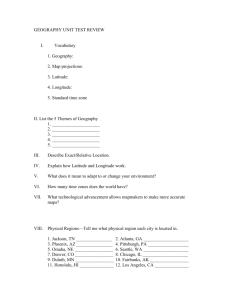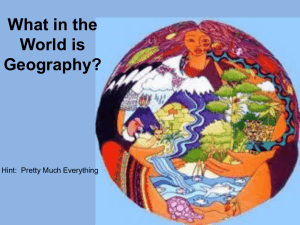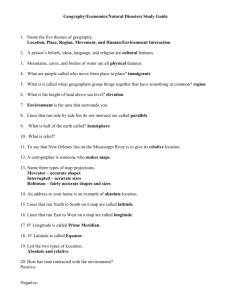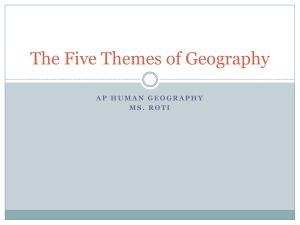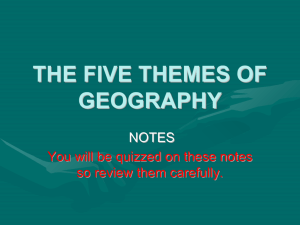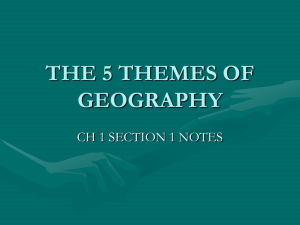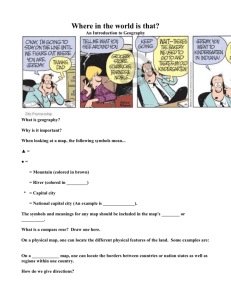Introduction to Geography
advertisement
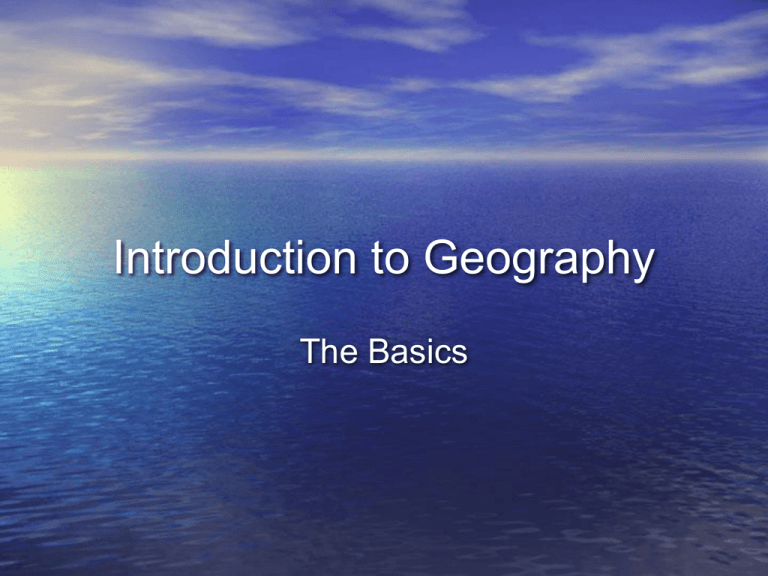
Introduction to Geography The Basics What is your definition of Geography? • Geography - study of where things are found on Earth’s surface and the reasons for the location • Human geographers ask: Where are people and activities found on Earth? Why are they found there? • Geography offers fundamental insights into the world in which we live through its concern with the spatial organization and character of the Earth’s surface. Two categories of Geography • Human geography - study of where and why human activities are located where they are • Physical geography - study of where and why natural forces occur as they do Our focus for the year • This year we will focus on human geography, but we must never forget about Earth’s atmosphere, land, water, vegetation, and other living creatures. We need to understand the interactions between people and their environment. Five themes of Geography • Geography’s spatial perspective promotes a focus on: 1. Location 2. Place 3. Human-environment interaction 4. Regions 5. Movement Opening question • How do people describe location? How do people tell others where something is? Location • "Where are we?” is the question that the theme Location answers. Location may be absolute or it may be relative. Relative Location • Relative locations are described by landmarks, time, direction or distance from one place to another and may associate a particular place with another. • Minnesota is west of Wisconsin, north of Iowa, south of Canada, and east of both North and South Dakota. Absolute location • Absolute location is a precise location on the Earth’s surface. • Parallels and meridians are two sets of imaginary arcs drawn in a grid pattern on Earth’s surface. Parallels • A parallel is a circle drawn • around the globe parallel to the equator. The numbering system to indicate the location of a parallel is called latitude. The equator is 0O latitude. The North Pole is 90O north latitude and the South Pole is 90O south latitude. Meridians • A meridian is an arc drawn • between the North and South pole. The location of each meridian is identified on Earth’s surface according to a numbering system known as longitude. The longitude that passes through Greenwich England is 0O longitude and is called the prime meridian. Meridians • The meridian on the opposite side of Earth is 180O longitude (also called the International Date Line). • All other meridians have numbers between 0O and 180O east or west, depending if they are either east or west of the prime meridian. Minutes • The precise location (mathematical location) of a place can be designated more precisely by dividing each degree into 60 minutes (“) Minneapolis is 45o53” North latitude and 93o13” West longitude Paris, France is 48o51” North latitude and 2O20” East longitude Marshall Islands are 10o00” North latitude and 165o00” East longitude Opening Questions • How does the environment influence our daily activities? • What ways do we change our environment? Place • What kind of place is it? What do you think of when you imagine China? Japan? Russia? Saudi Arabia? • Places have both human and physical characteristics. • What do you think is the difference between human and physical characteristics? Physical Characteristics • Physical characteristics include mountains, rivers, soil, beaches, wildlife, etc. Human characteristics • Places have human characteristics also. • These characteristics are derived from the ideas • and actions of people that result in changes to the environment, such as buildings, roads, clothing, and food habits. The image people have of a place is based on their experiences, both intellectual and emotional. People's descriptions of a place reveal their values, attitudes, and perceptions. Question???? • What are the physical and human characteristics of Minneapolis or Minnesota? How do these shape our lives? Human-environment Interaction • How do humans and the environment affect each other? • We change the environment and then sometimes Mother Nature changes it back.. • There are three key concepts to human/environmental interaction: Humans adapt to the environment. Humans modify the environment. Humans depend on the environment. • All places on Earth have advantages and disadvantages for human settlement. One person's advantage may be another person's disadvantage. • Environment is not just trees, spotted owls, and rain forests. Environment is a feeling. Questions???? • How do physical features affect us? How have we adapted to or changed our landscape? • Given the choice, where would you live? Why? What is the environment? How do people interact with the environment? Homework – If you could live anywhere • Pick three states that you would like to live in and tell me why. • Pick three countries that you would like to live in and tell me why. • Please type. Use as many details as possible to tell me why. 3-4+ sentences on why. Opening Question • What are different ways that people communicate with each other? • Name as many forms of transportation as you can. Region • The “sense of place” that humans possess may apply to a larger area of Earth. • A region is an area defined by one or more distinctive characteristics. Region A region derives its unified character through the cultural landscape - a combination of cultural features such as language and religion, economic features such as agriculture and industry, and physical features such as climate and vegetation. Carl Sauer • Carl Sauer (1889-1975) was a geographer who defined cultural landscape as an area fashioned from nature by a cultural group. “Culture is the agent, the natural area the medium, the cultural landscape is the result.” Three basic types of regions • Formal regions are those defined by governmental or administrative boundaries (i. e., United States, Minneapolis, Brazil). These regional boundaries are not open to dispute, therefore physical regions fall under this category (i. e., The Rockies, the Great Lakes States). The last two types of regions • Functional regions are those defined by a function (i. e., a newspaper service area).If the function ceases to exists, the region no longer exists. • Vernacular regions are those loosely defined by people's perception or cultural identity(i. e., The South, The Middle East). Questions???? • What region do we live in? • What type of region is it? What are its • characteristics? The Midwest, The Twin Cities, the Southwest community? What states do you define as the South? The Northeast? The West? What characteristics and perceptions go along with these regions? Opening • Write examples of how Minneapolis relates to the 5 themes. Movement • The movement of people, the import and export • of goods, and mass communication have all played major roles in shaping our world. People everywhere interact. They travel from place to place and they communicate. We live in a global village and global economy. Movement • People interact with each other through movement. Humans occupy places unevenly on Earth because of the environment but also because we are social beings. We interact with each other through travel, trade, information flows (EMail) and political events. Movement • Not only do humans move but also ideas move; • fashions move; fads move. What is an example of an idea that moves? Opening Question • What types of things can be shown on a map? Name as many things as possible. Maps • Map - a two-dimensional or flat-scale model of Earth’s surface, or a portion of it • Geography has a reliance on maps to display and analyze information • Cartography - science of mapmaking Two purposes of maps • Tool for storing reference material - helps us find the shortest distance to a place and helps us learn where in the world something is found • Tool for communication geographic information - distribution of human activities or physical features What is this map’s purpose? What is this map’s purpose? • Maps are used to portray the distinctive character of places; their relationship to environmental issues; the movements of people, goods, and ideas; and regions of various types. Opening question • What are some problems with maps? Name 5 things that should be included all maps 1. 2. 3. 4. 5. Title Map scale Compass rose Key or Legend Labels Map Scale • The level of detail and the amount of area • • covered on a map depend on its scale. Scale - the relationship between the size of an object on a map and the size of the actual feature on Earth’s surface. Scale can be presented in 3 ways: fraction(1/100) or a ratio (1:100), a written statement (“1 inch equals 100 miles”) or a graphic bar scale Projections • Earth is very nearly a sphere and therefore • • • accurately represented in the form of a globe. A globe is a limited tool. Why is this? The Earth’s shape poses a challenge, since flat maps will have some distortion. The scientific method of transferring locations on Earth’s surface to a flat map is called projection. How does this projection create a distorted image? How does this projection create a distorted image? The problem of distortion • The shape of an area can be distorted, • so that it appears more elongated or squat than in reality. The distance between two points may become increased or decreased. The problem of distortion • The relative size of different areas may • be altered, so that one area may appear larger than another on a map but is in reality smaller. The direction from one place to another can be distorted. Opening • What are some tools that geographers use? Contemporary Tools • GIS (geographic information system) - a computer system that can capture, store, query, analyze, and display geographic data. Contemporary Tools • Remote Sensing - the acquisition of data about the Earth’s surface from a satellite orbiting Earth or from other long-distance methods. • GPS ( Global Positioning System) - a system that accurately determines the precise position of something on Earth

